The sales industry is competitive. You must get ahead of market trends and ensure your sales pitch is top-notch. On top of that, you need to have strong interpersonal skills. There’s no way around it. That’s why customer references aren’t just “nice to have”. For Business Development Representatives (BDRs), Sales Development Representatives (SDRs), and Account Executives (AEs), customer references can be the secret weapon that accelerates the sales process. It also helps to build trust with prospective clients and ultimately helps close more deals.
If you’re part of a sales organization, this guide will explain exactly why customer references matter to your organization and how you can use them strategically to hit your sales targets within your workflow and build stronger business relationships for a successful career. Fret not, whether you’re a BDR, SDR, AE, account manager, hiring manager, sales leader, or another sales enablement professional, there’s something for you!
What is a Sales Organization?
Before discussing customer references, let’s understand the sales organization itself. A sales organization is a group of sales professionals within a company tasked with selling the company’s products or services to potential customers. The engine drives client acquisition, manages the sales pipeline, and supports company expansion.
Basic Forms of Sales Organizations
Sales organizations typically fall into a few basic structures:
- Line Sales Organization: The oldest and simplest form, where authority flows vertically, and each salesperson is responsible for their sales actions and outcomes. Common in smaller companies or those focused on a narrow product line.
- Functional Sales Organization: This organization divides the sales team by specific expertise or tasks, such as lead generation, closing deals, or account management. Specialization improves efficiency but requires strong coordination.
- Hybrid Structures: Many companies combine these elements to fit their unique needs, blending roles like BDRs, SDRs, and AEs to optimize the sales process.
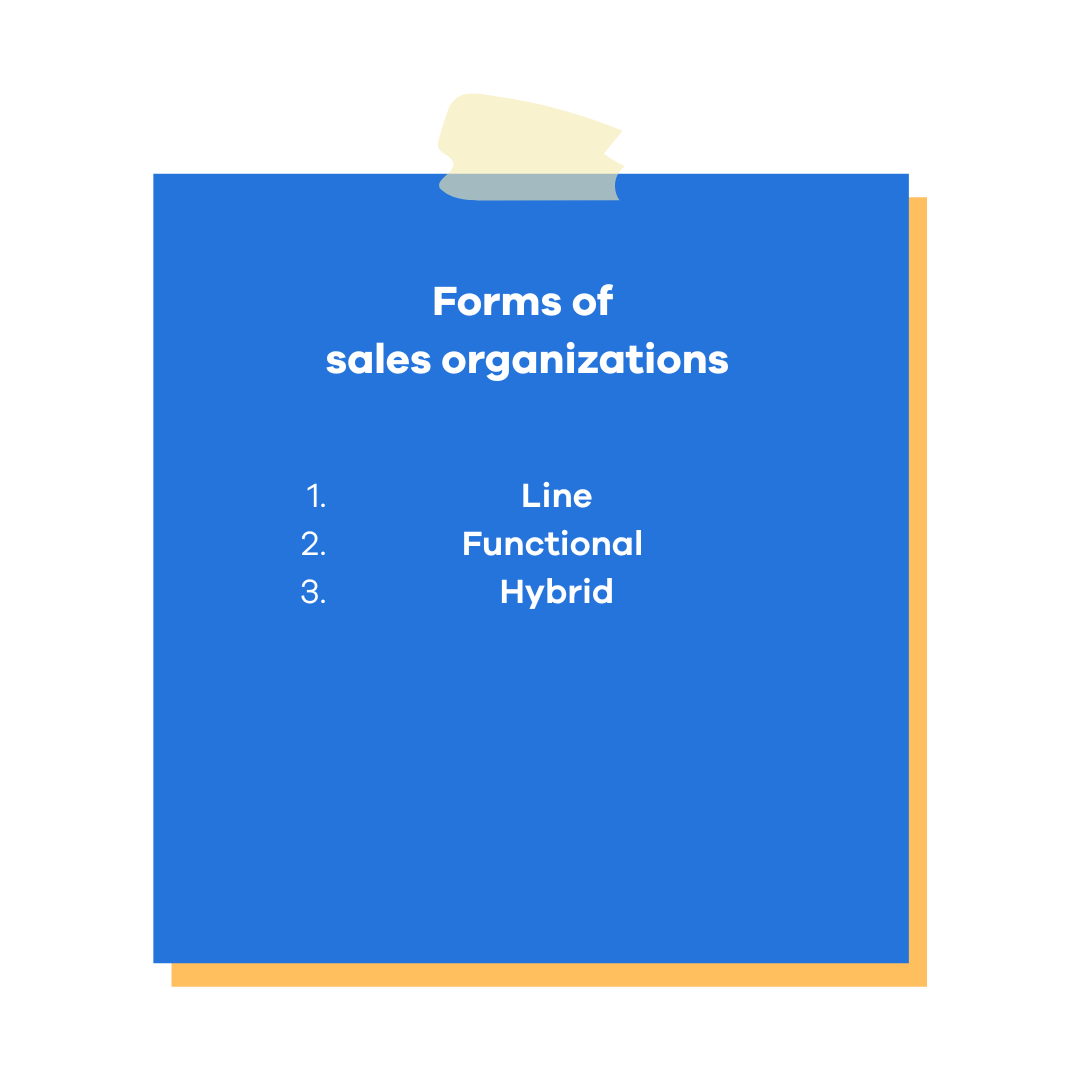
Typical Sales Organizational Structure
Most modern sales organizations include:
- Sales Leader / Head of Sales: Responsible for developing and executing the overall sales strategy to drive revenue growth and achieve company objectives.
- Sales Manager: Oversees a specific sales team or region, managing day-to-day sales activities and ensuring the team meets its quotas. They provide coaching, set clear performance expectations, and support sales reps in closing deals.
- Business Development Representatives (BDRs): Focused on outbound prospecting and generating new business opportunities. This is sometimes an entry level role.
- Sales Development Representatives (SDRs): Handle inbound lead qualification and early engagement.
- Account Executives (AEs): Responsible for managing client accounts, negotiating contracts, and closing deals.
- Customer Success Managers (CSMs): Support existing clients to ensure satisfaction and retention.
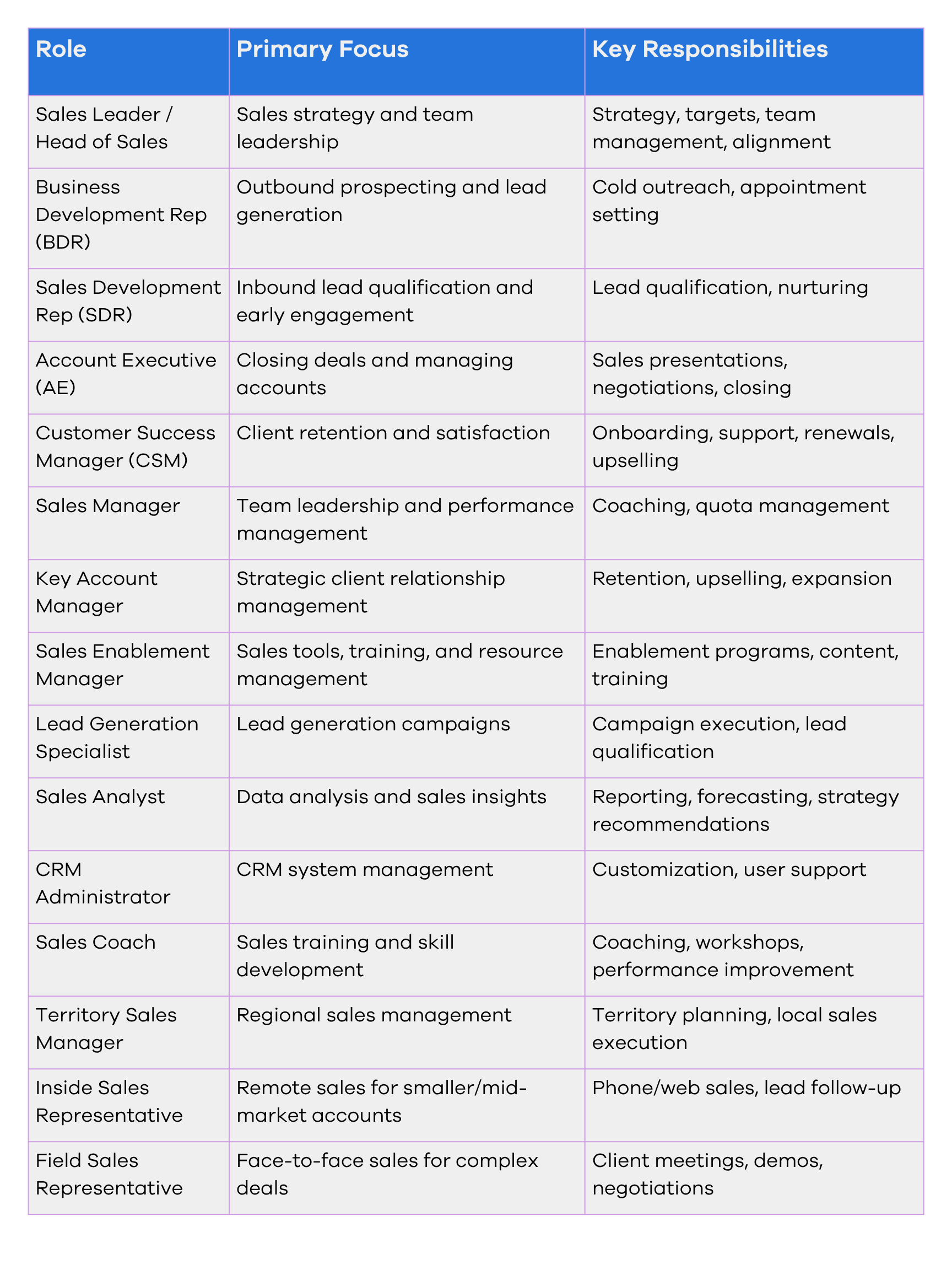
The core of each role may vary depending on the company, but not too much. Below, we’ll explore BDRs, SDRs, and AE a little more!
What Makes Sales Successful at Any Organization?
Here’s what the most successful sales organizations are doing:
1. Establish Clear Roles and Responsibilities
A well-defined sales organization delineates roles and responsibilities to avoid confusion and overlap. This clarity ensures that each team member understands their specific duties and how they contribute to the overall sales goals. Typical roles include:
- Sales Development Representatives (SDRs) who focus on lead generation and qualification.
- Account Executives (AEs) are responsible for closing deals and managing client relationships across multiple accounts.
- Sales Managers oversee the team, set goals, and develop strategies. Must have excellent organizational skills.
- Customer Success Representatives focus on client retention and upselling across multiple clients.
- Sales Specialists have expert knowledge to assist in complex sales situations.
- Business Development Representatives (BDRs) focus on outbound prospecting and conducting in-depth market research to identify potential clients and new business opportunities. They’re focused on prospective customers.
2. Define Sales Processes and Pipeline Stages
A structured sales process maps out each step from prospecting to closing a deal. This provides a repeatable framework for sales reps to follow. Defining pipeline stages such as lead qualification, needs analysis, proposal, and closing helps track progress and identify bottlenecks. A tailored sales pipeline aligned with the company’s goals and customer base simplifies daily activities and improves forecasting accuracy.
Regularly revising the sales process with team input ensures it remains effective and adaptable. Using sales process management tools or CRM systems enhances deal status visibility and fosters team collaboration.
3. Effective Collaboration With Marketing and Customer Success Teams
Effective sales organizations work with marketing and customer success teams throughout the customer journey. Marketing generates qualified leads and supports sales with relevant content and campaigns. Sales teams provide feedback on lead quality and customer needs to marketing. Customer success ensures smooth onboarding and retention, returning insights to sales for upselling opportunities.
Cross-functional alignment leads to better expectation setting, consistent messaging, and a unified experience for prospects and clients. Joint planning and communication break down silos and maximize revenue potential
4. Focus on Client Acquisition and Retention
A balanced sales organization prioritizes both acquiring new clients and retaining existing ones. While SDRs and AEs drive new business, customer success representatives focus on nurturing relationships, ensuring satisfaction, and identifying opportunities for renewals or upselling.
Retention efforts reduce churn and increase lifetime customer value, which is critical for sustainable growth. Coordinated efforts between sales and customer success teams ensure clients receive ongoing value and support, reinforcing loyalty.
5. Track Specific Metrics and Quotas to Track Performance
Sales organizations use clear metrics and quotas to measure individual and team performance. Key performance indicators (KPIs) often include:
- Number of leads generated
- Conversion rates at each pipeline stage
- Sales cycle length
- Revenue generated
- Annual quota attainment
Tracking these metrics enables managers to identify high performers, areas needing improvement, and the effectiveness of sales strategies. Data-driven insights from sales operations can further improve sales processes and resource allocation.
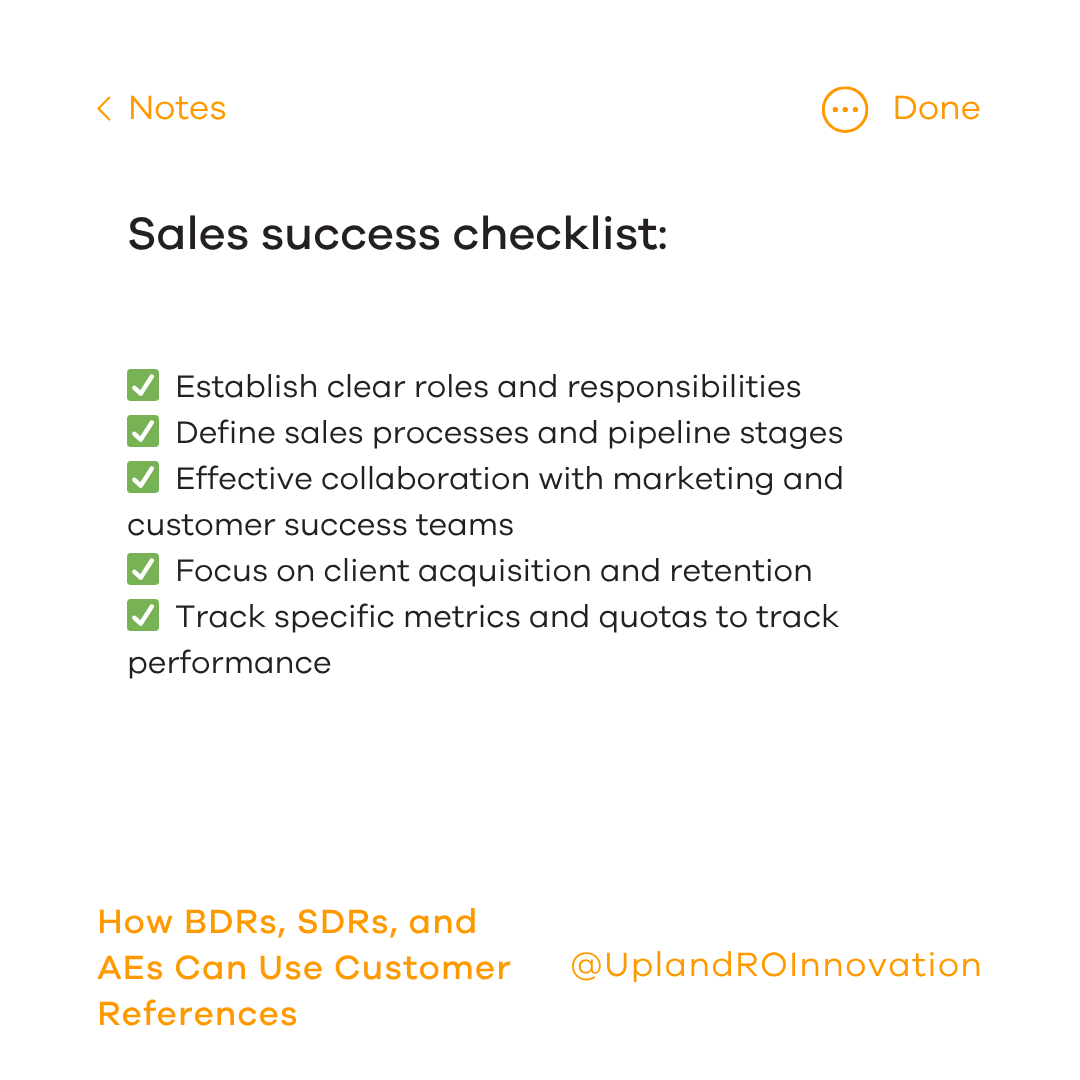
Understanding the Roles: BDRs, SDRs, and AEs
BDRs, SDRs, and AEs perform specific tasks.
What Is a Business Development Representative (BDR)?
A BDR is a sales professional focused on outbound prospecting — reaching out to potential clients who have not yet expressed interest. They aim to generate new business opportunities by researching, qualifying leads, and setting meetings for AEs. BDRs often perform cold calling, email outreach, and networking to build a pipeline of prospective clients. Soft skills are important here.
BDRs typically earn a base salary plus commission or bonuses tied to meeting quotas, such as the number of qualified leads generated or meetings booked.
What Is a Sales Development Representative (SDR)?
An SDR is a sales professional focused on the early stages of the sales process, primarily responsible for identifying, engaging, and qualifying inbound leads or marketing-generated prospects. Active listening is important here. They aim to nurture these potential customers through initial conversations, understand their needs, and determine if they are a good fit before passing them on to AEs for closing. Excellent communication skills are essential here.
SDRs use tools like cold calling, email outreach, social selling, and CRM systems to build relationships and maintain an active pipeline of qualified leads. This role is often an entry point into sales, offering valuable experience in communication, research, and lead qualification that can lead to career growth within sales or business development.
What Is an Account Executive (AE)?
You might be wondering how Account Executives (AEs) work and what they do. An AE is a sales professional responsible for managing client accounts, negotiating contracts, and closing deals. AEs work closely with qualified leads, guiding them through the sales process by understanding their needs, presenting tailored solutions, and addressing objections. They build and maintain strong relationships with new and existing clients to ensure satisfaction and identify opportunities for upselling or cross-selling.
AEs often have sales quotas and are key drivers of revenue growth. They coordinate with internal teams to deliver products or services as promised. This role requires strong communication, negotiation, and problem-solving skills, making it critical for sustaining and expanding a company’s customer base.
Usually, AEs are not entry-level; many start as SDRs or BDRs and advance to AE roles after gaining experience. AEs typically earn higher salaries than BDRs and SDRs. Their higher position within the sales hierarchy means their base salaries often range from $60,000 to $100,000 or more, plus commissions that can significantly boost total earnings.
What Is the Difference Between SDR and BDR?
While often used interchangeably, there is a key distinction:
- SDRs primarily handle inbound leads — qualifying prospects interested in contacting the company or engaging with marketing content.
- BDRs focus on outbound prospecting — seeking new business opportunities through cold outreach and networking.
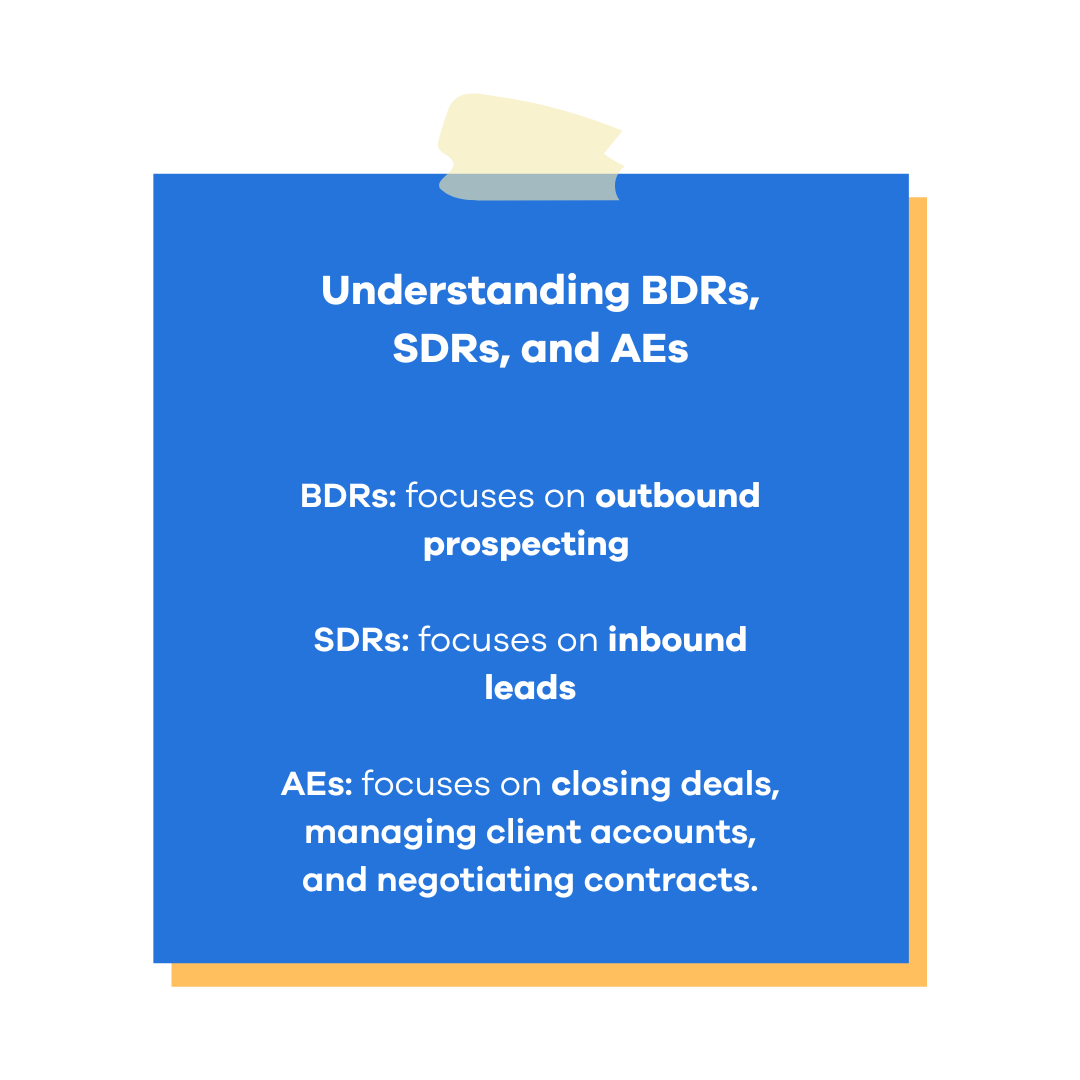
Why Customer References Matter to BDRs, SDRs, and AEs
A customer reference is a testimonial or endorsement from a current or past client that validates the value and effectiveness of a company’s products or services. Customer references can take many forms:
- Written case studies
- Video testimonials
- Quotes and reviews
- Customer success stories
- Referral introductions
Writing a practical customer reference involves:
- Identifying a satisfied client willing to share their story
- Highlighting specific business challenges the client faced
- Describing how your company’s products or services solved those challenges
- Including measurable results and benefits (e.g., increased revenue, cost savings)
- Using clear, authentic language that resonates with your target audience
Customer references are powerful because they:
- Build trust and credibility: Prospective clients trust peer recommendations more than marketing messages. 88% of consumers trust recommendations from friends or colleagues over other forms of advertising.
- Shorten the sales cycle: References help prospects overcome objections faster by providing proof of success.
- Increase conversion rates: Leads exposed to customer references are likelier to convert and become loyal clients.
- Support complex sales: For high-value or technical products, references validate claims and reduce perceived risk.
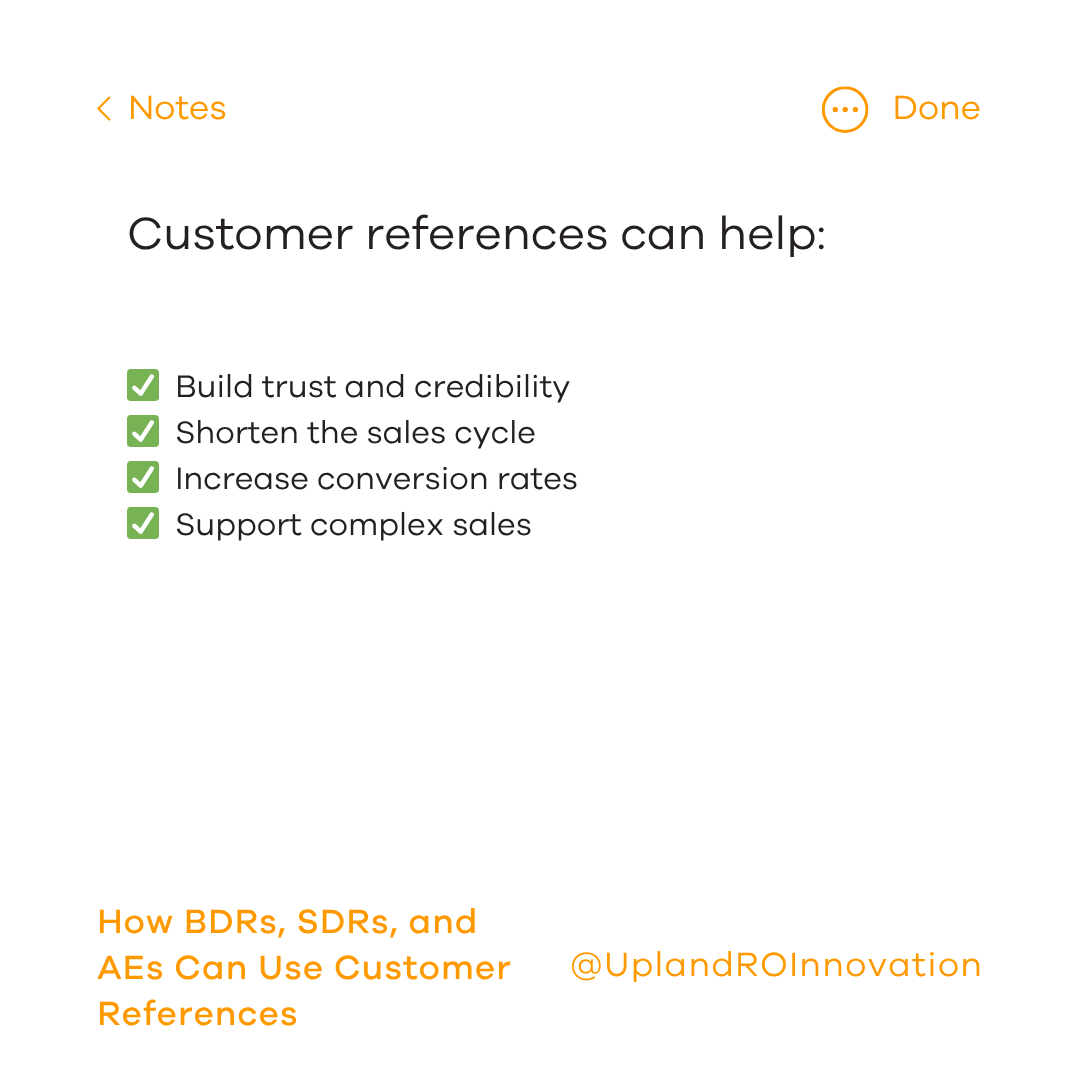
How BDRs Can Use Customer References
BDRs are the first line of outreach, so customer references can help them:
- Qualify leads more effectively: Sharing relevant success stories during cold calls or emails can pique interest and open doors.
- Personalize outreach: Tailor references to the prospect’s industry or pain points to demonstrate relevance.
- Build rapport: Mentioning well-known clients or similar companies builds credibility early.
- Set meetings: References can be a compelling reason for prospects to agree to a discovery call or demo.
Example: A BDR reaching out to a healthcare prospect might say, “We recently helped a hospital system reduce patient onboarding time by 30%. I’d love to schedule a quick call to explore how we can do the same for you.”
How SDRs Can Use Customer References
SDRs work inbound leads and nurture early relationships. They can:
- Validate the prospect’s interest: When a lead engages, sharing a relevant case study or testimonial reinforces their decision to explore further.
- Address objections: If prospects express doubts, SDRs can provide references that showcase how similar clients overcame those challenges.
- Support qualification: References help SDRs confirm the fit between the prospect’s needs and the company’s products.
- Hand off to AEs: Equipping AEs with reference material gathered during qualification smooths the transition.
Example: A SDR can provide a case study on how the company’s software helped a hospital system reduce patient onboarding time by 30% to an engaging lead.
How AEs Can Use Customer References
AEs are responsible for closing deals, so customer references are critical tools for:
- Negotiating contracts: References demonstrate ROI and reduce perceived risk, helping close deals faster.
- Building long-term relationships: Sharing success stories fosters trust and positions the AE as a trusted advisor.
- Upselling and cross-selling: References from clients who expanded their use of products can encourage existing clients to do the same.
- Renewals and retention: Positive references support contract renewals and reduce churn.
Example: An AE can use the same case study to demonstrate ROI when renewing or negotiating contracts, upselling, cross-selling, and just building a relationship with the customer.
Best Practices for Using Customer References Across Sales Roles
Use customer references wisely across your entire sales organization.
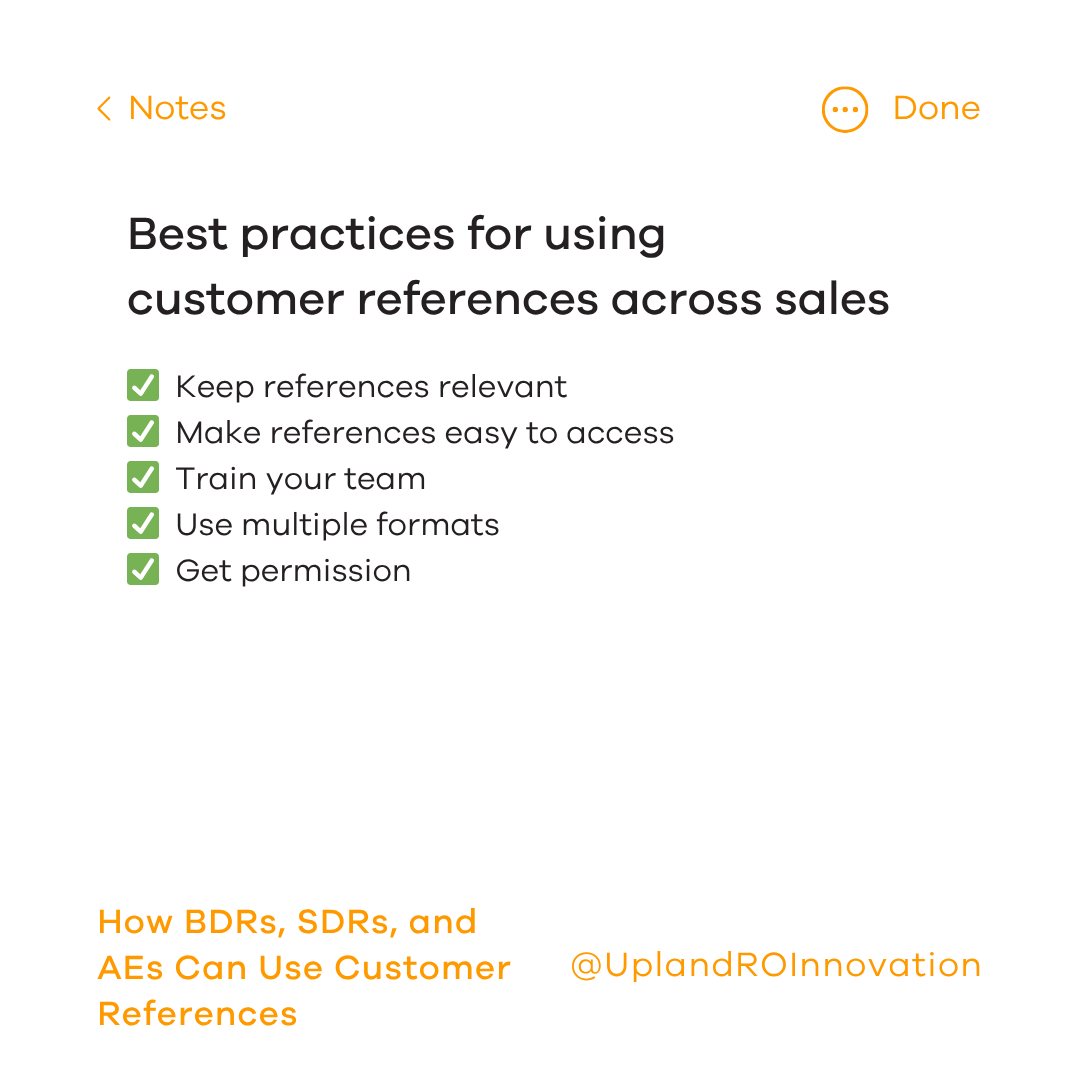
1. Keep references relevant
Match customer references closely with the prospect’s industry, company size, and specific pain points to improve their impact. Prospective customers are more likely to trust and relate to references that reflect their own business environment and challenges.
For example, a case study from a similarly sized company in the same sector facing comparable issues will resonate far more than a generic success story. Tailoring references in this way not only builds credibility but also helps prospects envision how your solution can address their unique needs, accelerating trust and decision-making in the sales process.
2. Make references easy to access
Sales teams need quick and seamless access to customer references to leverage them effectively during conversations and presentations. Implementing a centralized repository or a sales enablement platform ensures that BDRs, SDRs, and AEs can easily search for and retrieve the most relevant references anytime.
This system eliminates delays caused by hunting down information or relying on memory. It enables sales reps to respond promptly to prospect inquiries with compelling, targeted proof points. A well-organized reference library also supports consistency and scalability in how references are used across the organization.
3. Train your team
Regular coaching is essential to help sales reps understand how to use customer references strategically and naturally within their interactions. Training should cover when to introduce references, tailor the story to the prospect’s context, and use references to overcome objections or build confidence.
Role-playing, sharing best practices, and reviewing successful reference usage can reinforce these skills. Equipping your team with this knowledge ensures that references become a powerful tool rather than an afterthought, enhancing the overall effectiveness of the sales process.
4. Use multiple formats
Potential prospects engage with content in different ways, so using a variety of reference formats broadens your reach and impact. Written case studies provide detailed narratives and data, while video testimonials add authenticity and emotional connection.
Offering multiple formats ensures that sales teams can select the most appropriate and compelling reference type for each situation. This caters to diverse buyer preferences and stages in the sales funnel.
5. Get permission
Ethical and professional reference programs always start with obtaining explicit consent from clients before using them as references. This step protects customer relationships and ensures transparency.
Preparing clients for potential outreach by informing them about what to expect, the types of questions they may receive, and the time commitment involved helps set clear expectations. Respecting clients’ boundaries and availability prevents reference fatigue and maintains goodwill. This encourages ongoing participation and long-term advocacy.
The Impact of Customer References on Sales Metrics
Companies that actively use customer references in their sales processes can experience up to a 70% increase in conversion rates. This demonstrates how powerful social proof is in influencing buying decisions. Why? Prospects gain confidence when they see how similar customers have successfully used a product or service, reducing perceived risk and accelerating trust.
Furthermore, referred leads tend to close 30% faster than non-referred leads. Referred leads shorten the sales cycle and enable sales teams to allocate resources more efficiently. This faster closing rate is attributed to the credibility and validation that references provide early in the buyer’s journey.
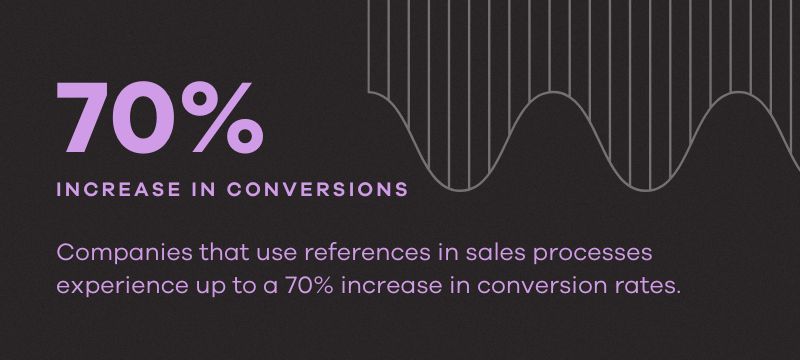
In addition to improved conversion and speed, customers acquired through references show 16% higher lifetime value and remain loyal 37% longer than those acquired through other channels. This increased lifetime value reflects stronger customer satisfaction and engagement, translating into repeat purchases, upselling opportunities, and lower churn rates. The longer retention period reduces acquisition costs over time and contributes to more stable revenue streams.
Sales teams that integrate customer references into their sales process consistently outperform their peers, exceeding quotas by 20% or more. This outperformance highlights how references not only help close deals but also improve overall sales productivity and morale by providing tangible success stories to share with prospects.
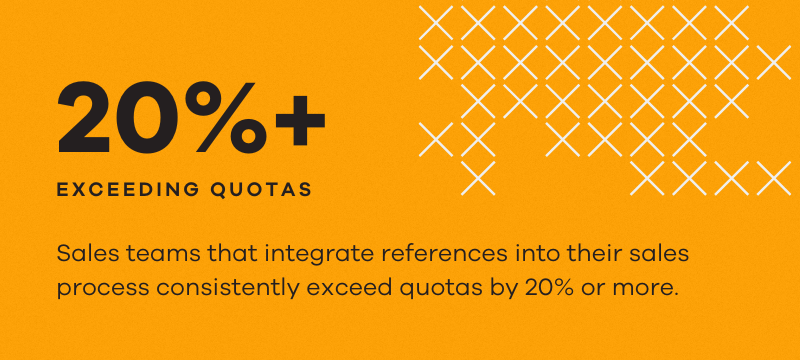
These findings are supported by research showing that referred customers generate 16% more profit and have 37% longer retention, with an 18% lower churn rate compared to non-referred customers. The strategic use of references—ranging from testimonials and case studies to live reference calls—can transform sales conversations. They them more persuasive and aligned with buyer concerns.
Sales organizations that prioritize building and managing a robust customer reference program gain a competitive advantage. They drive higher conversion rates, faster sales cycles, and more valuable, long-lasting customer relationships.

Customer References and Upland RO Innovation Are Your Sales Team’s Secret Weapon
For BDRs, SDRs, and AEs, customer references are more than just nice-to-have collateral — they’re essential tools that build trust, shorten sales cycles, and help close deals. By integrating customer references into every stage of the sales process, from initial outreach to contract negotiation, sales teams can elevate their game and drive company growth.
Sales leaders and enablement professionals should prioritize creating a robust customer reference program, training reps on its use, and making references easily accessible. When your sales reps confidently share real client success stories, they don’t just sell product. They sell proven value.
If you’re ready to empower your sales organization with the power of customer references, start by identifying your happiest clients, crafting compelling reference content, and embedding it into your sales playbooks. Your BDRs, SDRs, and AEs will thank you—and so will your sales pipeline.
Let’s grow your reference and sales pipeline. Give Upland RO Innovation a spin now.
